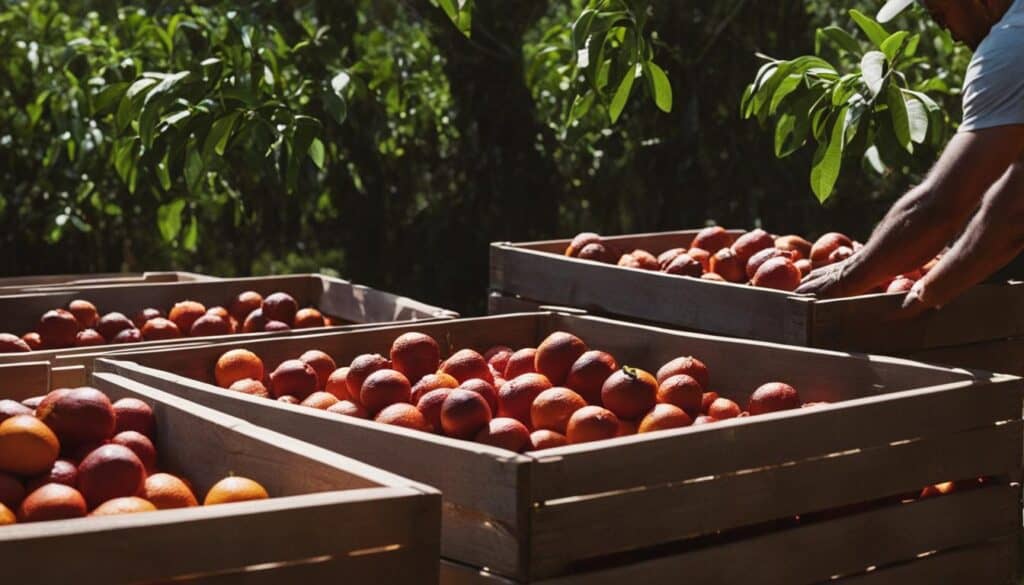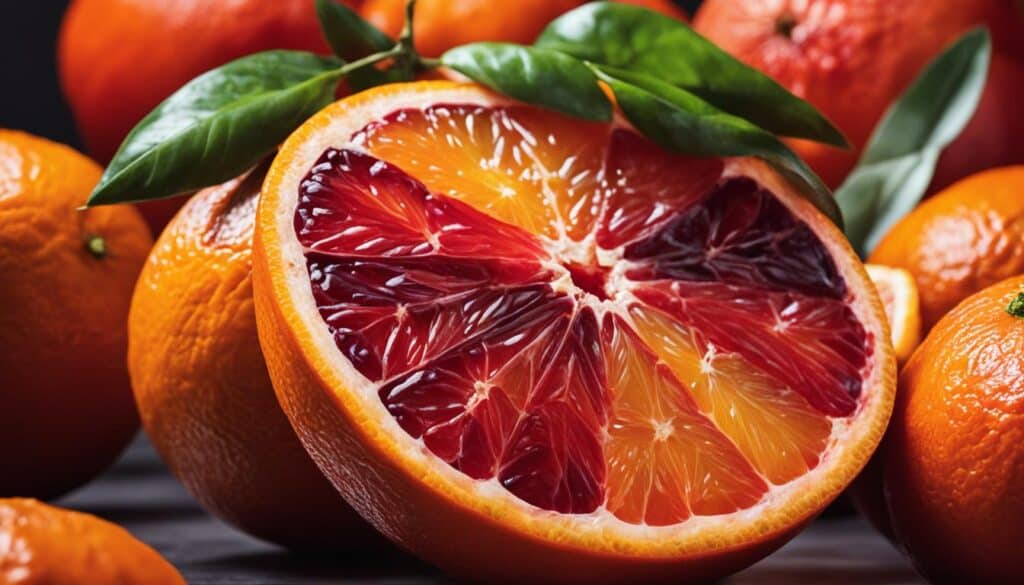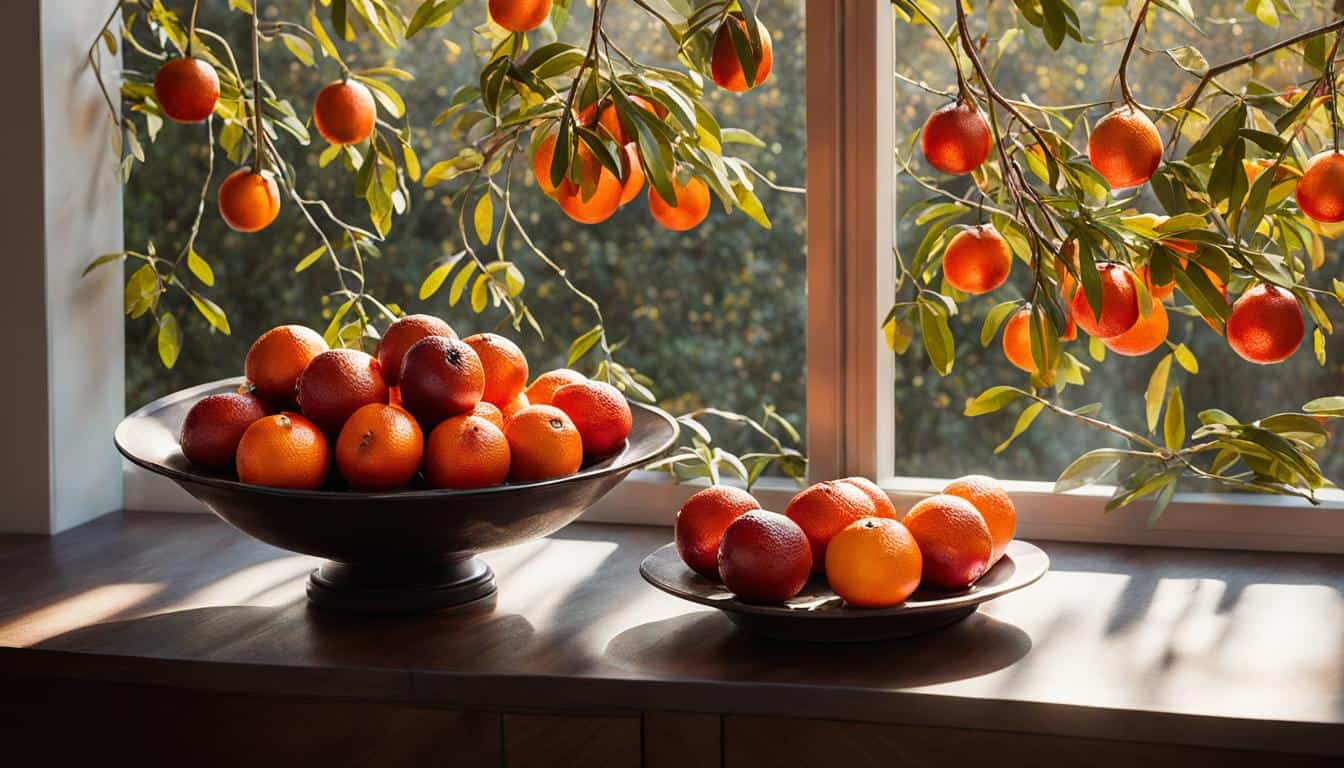I’m excited to introduce you to a fascinating fruit that looks like an orange on the outside but surprises with its crimson-colored flesh on the inside. It’s called a blood orange, and it’s a true delight for the senses. Just imagine biting into a fruit that resembles a classic orange but reveals a vibrant red interior, a unique and captivating experience that combines the familiar with the unexpected.
What makes blood oranges so special is the presence of a pigment called anthocyanin, which gives them their remarkable red color. This pigment develops when night temperatures are low, adding an alluring hue to the fruit. Despite the striking appearance, blood oranges share many similarities with regular oranges, such as a round shape and a refreshing citrus scent.
But that’s not all—the flavor profile of blood oranges sets them apart. While they have a hint of tanginess reminiscent of navel oranges, they also offer a more complex taste with floral undertones. This delightful combination makes them a favorite among citrus enthusiasts who appreciate the unexpected harmony of flavors.
But there’s more to blood oranges than meets the eye. These fruits are packed with nutritional benefits, making them an excellent choice for health-conscious individuals. They are rich in antioxidants, including anthocyanin, which has been associated with potential cancer-fighting properties. Blood oranges also boast a high vitamin C content, promoting a strong immune system, and their fiber content supports weight loss efforts by enhancing feelings of fullness.
Key Takeaways:
- Blood oranges have a red flesh that develops due to the presence of anthocyanin pigment.
- They have a unique flavor, combining floral undertones with tanginess.
- These fruits are high in antioxidants and vitamin C, offering potential health benefits.
- Blood oranges’ fiber content aids in weight loss by promoting a feeling of satiety.
- Their availability in the United States is between October and May, with the peak season in February and early March.
The Origins of Blood Oranges
Blood oranges, with their vibrant red flesh, have a fascinating history that can be traced back to the southern Mediterranean region. The exceptional climate conditions in this area contribute to the development of anthocyanins, the pigments responsible for the striking coloration of blood oranges.
The Mediterranean climate, characterized by mild winters and warm summers, provides the perfect environment for blood oranges to thrive. The region’s long, hot summers facilitate the growth of the fruit, while the cool nights in fall and winter create the ideal conditions for anthocyanin development.
The process of anthocyanin development in blood oranges is influenced by temperature fluctuations, particularly during the night. When exposed to cooler temperatures, the citrus fruits undergo a chemical reaction that triggers the production of anthocyanin, resulting in their distinctive red pigmentation.
The unique combination of the Mediterranean climate and optimal temperature variations allows blood oranges to flourish in this region, giving them their signature appearance and flavor.
Availability of Blood Oranges
Blood oranges are a delightfully unique citrus fruit that captures the attention and taste buds of many. Their availability in the United States occurs between October and May, with the peak season falling within February and early March. During this time, blood oranges can be easily found in a variety of locations, allowing enthusiasts to indulge in their vibrant flavors.
The cultivation of blood oranges thrives in areas with a climate similar to their Mediterranean origins. The United States boasts the ideal conditions for these fruits to flourish, particularly in California and Florida. These states provide the warm daytime temperatures and cool nights necessary to develop the signature red flesh and exquisite flavor profiles of blood oranges.
During the peak season, blood oranges grace the shelves of grocery stores and farmers’ markets in California and Florida. It is also possible to find these captivating citrus fruits in specialty shops throughout other parts of the country. Whether you’re a seasoned blood orange aficionado or a curious newcomer, accessing these delightful fruits is a matter of convenience, especially during their prime harvest time.
Discover the allure of blood oranges and savor their unique flavors while they are in abundance. Embrace the opportunity to incorporate these vibrant citrus wonders into your culinary creations.
How to Select and Store Blood Oranges
When it comes to enjoying the unique flavors of blood oranges, selecting the right fruits and storing them properly is essential. Here are some tips to help you choose and store blood oranges for maximum freshness and flavor.
Selecting Blood Oranges
When selecting blood oranges, it’s important to consider their weight and aroma rather than solely relying on the color of their rind. Follow these steps:
- Choose blood oranges that feel heavy for their size, as this indicates juiciness and freshness.
- Check for a citrusy scent at the stem end, as this is a sign of ripeness and flavorful flesh.
- Remember that the rind color may vary, ranging from bright orange to deep red, and doesn’t necessarily indicate the flavor intensity or sweetness.
By focusing on weight and smell, you can select blood oranges that are ready to be enjoyed.
Storing Blood Oranges
Proper storage is vital to maintain the freshness and quality of blood oranges. Here’s how to store them:
- Short-Term Storage: If you plan on consuming blood oranges within a day or two, it’s best to store them at room temperature. Keep them in a cool, dry place away from direct sunlight to preserve their juiciness.
- Long-Term Storage: To extend the shelf life of blood oranges, it’s recommended to refrigerate them. Place them in the crisper drawer of your refrigerator, which helps maintain humidity and freshness. When stored properly in the fridge, blood oranges can last for about 10 days.
Remember to keep blood oranges away from strong-smelling foods, as they can absorb odors easily.

By following these guidelines for selecting and storing blood oranges, you can ensure that they remain fresh and flavorful for longer periods, allowing you to savor their unique taste in various culinary creations.
Different Varieties of Blood Oranges
When it comes to blood oranges, there are several different varieties to choose from. Each variety has its own unique taste and appearance, adding to the allure of this vibrant citrus fruit.
The Moro Blood Orange
The Moro blood orange is the most common variety in the United States. It is characterized by its deep red flesh and intense berry-like flavor. The Moro blood orange has a rich, tart taste with hints of raspberry and citrus. Its distinct color and bold taste make it a favorite among blood orange enthusiasts.
The Tarocco Blood Orange
The Tarocco blood orange is renowned for its exceptional sweetness. It is often considered the sweetest variety of blood orange available. The Tarocco blood orange has a mildly tangy flavor accompanied by notes of raspberry and berry. Its sweetness and juiciness make it perfect for enjoying on its own or adding to salads and desserts.
The Sanguinelli Blood Orange
The Sanguinelli blood orange is sweeter than the Moro but not as sweet as the Tarocco. It has a balanced and refreshing taste with a mild tartness. The Sanguinelli blood orange offers a delicate blend of citrus flavors, including hints of raspberry and strawberry. Its vibrant red flesh and nuanced taste make it a versatile choice for a wide range of culinary applications.
Whether you prefer the intense berry-like flavor of the Moro, the exceptional sweetness of the Tarocco, or the balanced taste of the Sanguinelli, each variety of blood orange offers a unique and delightful citrus experience.
“The different varieties of blood oranges provide a range of flavors and characteristics, allowing you to explore and appreciate the nuances of this extraordinary fruit.”

| Variety | Color | Taste |
|---|---|---|
| Moro | Deep red | Intense, berry-like |
| Tarocco | Varies (light to deep red) | Exceptionally sweet, tangy |
| Sanguinelli | Red | Refreshing, balanced |
Blood Oranges and Their Nutritional Benefits
Blood oranges are not only delicious but also packed with essential nutrients that can benefit your health. Let’s explore the nutritional benefits that these vibrant citrus fruits have to offer:
Antioxidants for Overall Well-being
One of the standout features of blood oranges is their rich antioxidant content, primarily attributed to the pigment known as anthocyanin. Antioxidants play a crucial role in neutralizing harmful free radicals in the body, which can cause cellular damage and lead to chronic diseases like cancer.
“The anthocyanin pigment found in blood oranges has been linked to potential cancer-fighting properties.”
Vitamin C for Immune Support
Another significant nutritional benefit of blood oranges is their high vitamin C content. Vitamin C is a powerful antioxidant that helps boost the immune system, promoting overall health and well-being. It plays a crucial role in supporting the integrity of blood vessels and aids in the absorption of iron.
Fiber for Weight Loss
If you’re looking to shed a few pounds or maintain a healthy weight, blood oranges can be a great addition to your diet. They are an excellent source of dietary fiber, which can help promote satiety and reduce cravings, aiding in weight loss efforts.
Now, let’s take a closer look at the nutritional composition of blood oranges:
| Nutrient | Amount per 100g |
|---|---|
| Calories | 43 |
| Carbohydrates | 9g |
| Dietary Fiber | 2g |
| Sugar | 7g |
| Protein | 0.9g |
| Fat | 0.2g |
| Vitamin C | 43mg |
| Potassium | 181mg |
| Calcium | 43mg |
| Iron | 0.3mg |

Other Red-Fleshed Citrus Fruits
In addition to blood oranges, there are other red-fleshed citrus fruits worth exploring. One such fruit is the cara cara orange. While it may resemble a blood orange from the outside, the cara cara has its own distinct characteristics.
The cara cara orange is a small navel orange with a lighter flesh color compared to blood oranges. It boasts a vibrant reddish-pink hue that adds a pop of color to any dish. The flavor of cara cara oranges is slightly milder and sweeter than that of blood oranges.
Unlike blood oranges, which get their red color from anthocyanins, cara cara oranges derive their color from carotenoids. These carotenoids contribute to the softer, pinkish-red tone of the flesh.
While cara cara oranges and blood oranges may be visually similar, their taste and aroma set them apart. Blood oranges offer a more complex and tart flavor profile, while cara cara oranges tend to be sweeter and have hints of cherry and cranberry.
To summarize the differences:
| Blood Oranges | Cara Cara Oranges |
|---|---|
| Deep red flesh | Lighter pinkish-red flesh |
| Tart, complex flavor | Sweet flavor with hints of cherry and cranberry |
| Anthocyanin pigments | Carotenoid pigments |
The unique characteristics of both blood oranges and cara cara oranges add variety to citrus offerings, allowing for diverse culinary experiences.

Explore the range of red-fleshed citrus fruits to discover new flavors and create visually stunning dishes. Whether you’re opting for the boldness of blood oranges or the sweetness of cara cara oranges, these fruits are sure to add vibrancy and zest to your culinary creations.
Growing Blood Oranges at Home
Have you ever dreamed of cultivating your own blood oranges? With the right climate, you can transform your backyard into a citrus paradise. Home cultivation allows you to enjoy the bountiful harvest of these vibrant red-fleshed fruits right from your own garden.
To successfully grow blood oranges at home, you need to ensure they are planted in the optimal climate. Blood oranges thrive in USDA Zones 9-10, where the weather conditions are favorable for their growth.
Here are the key climate requirements for growing blood oranges:
- Sun: Blood oranges require full sun exposure to thrive. Make sure to choose a location in your garden that receives at least 6-8 hours of direct sunlight each day.
- Soil: The soil should be moist but well-draining to prevent waterlogging. Blood oranges prefer slightly acidic soil with a pH level of 6 to 7.
- Temperature: Blood oranges are sensitive to extreme cold and frost. They flourish in warm temperatures ranging between 60-85 degrees Fahrenheit. Ensure the temperature doesn’t drop below freezing point.
If you live in an area with cooler climates or have limited garden space, don’t worry! Blood oranges can also be grown in larger containers and brought indoors during colder temperatures. This allows you to enjoy the beauty and taste of blood oranges all year round.
“Growing blood oranges at home brings the joy of harvesting your own fresh, juicy fruits and adds a touch of natural beauty to your surroundings.”
If you’re ready to embark on the journey of home cultivation, here’s a brief overview of the steps involved:
Steps for Growing Blood Oranges at Home:
- Select a suitable location in your garden with full sun exposure.
- Prepare the soil by ensuring it is well-draining and slightly acidic.
- Dig a hole that is twice the width and depth of the rootball of your blood orange tree.
- Place the tree in the hole, ensuring the graft union (the bulge where the tree was grafted onto the rootstock) is above the soil level.
- Backfill the hole with soil, gently firming it around the base of the tree.
- Water the tree thoroughly to settle the soil.
- Mulch around the base of the tree to help retain moisture and suppress weeds.
- Water regularly, ensuring the soil remains evenly moist but not waterlogged.
- Prune the tree as needed to maintain its shape and remove any dead or diseased branches.
- Monitor for pests and diseases, and take appropriate action if necessary.
- Patience is key! It may take a few years for your blood orange tree to bear fruit, but the wait will be worth it.
Now that you have the knowledge and guidance, it’s time to roll up your sleeves and start growing your own blood oranges. With a little care and attention, you’ll soon be rewarded with a bountiful harvest of these delicious and visually stunning fruits.
Popular Blood Orange Recipes
Blood oranges are not only versatile but also add vibrant colors and tantalizing flavors to a range of recipes. Whether you’re looking to satisfy your sweet tooth or explore savory options, incorporating blood oranges into your dishes will add a unique twist to your culinary creations. Here are some popular blood orange recipes to inspire your next gastronomic adventure:
Blood Orange Yogurt Olive Oil Cake
If you’re a fan of moist and flavorful cakes, then this blood orange yogurt olive oil cake is a must-try. The combination of tangy blood orange zest, creamy yogurt, and rich olive oil creates a heavenly cake that is both decadent and refreshing. Serve it as a dessert or a delightful treat for afternoon tea.
Citrus Salad with Blood Orange Segments
Take your salad game to the next level with this refreshing citrus salad featuring blood orange segments. The juicy sweetness of blood oranges pairs perfectly with a mix of fresh greens, tangy vinaigrette, and other citrus fruits like grapefruit and mandarin. It’s a burst of flavor and color on your plate, providing a vibrant and healthy option for any meal.
Blood Orange Galette
Indulge in the rustic charm of a blood orange galette, a free-form tart that showcases the natural beauty of blood oranges. The sweet and slightly tart blood orange slices are arranged on a flaky pastry crust and baked to perfection. This dessert is simple yet elegant, making it a delightful centerpiece for any special occasion.
Blood Orange Ceviche
For a unique twist on the classic ceviche, try incorporating blood oranges into the mix. The bright, tangy flavors of blood orange juice and segments complement the fresh seafood and zesty marinade, creating a refreshing and citrusy take on this popular dish. Serve it as an appetizer or a light meal to impress your guests.
| Recipe | Description |
|---|---|
| Blood Orange Yogurt Olive Oil Cake | A moist and flavorful cake infused with blood orange zest, yogurt, and olive oil. |
| Citrus Salad with Blood Orange Segments | A refreshing salad that combines mixed greens, blood orange segments, and tangy vinaigrette. |
| Blood Orange Galette | A rustic tart featuring blood orange slices on a flaky pastry crust. |
| Blood Orange Ceviche | A unique twist on ceviche that incorporates the citrusy flavors of blood oranges. |
These recipes are just a starting point to explore the wonderful world of blood oranges in your kitchen. Experiment with different ingredients and techniques to create your own culinary masterpieces. Whether you choose to showcase the bold flavors in a cake, salad, tart, or seafood dish, blood oranges are sure to elevate your cooking and bring a burst of color and taste to the table.
Different Types of Blood Oranges at the Farmers Market
At farmers markets, you’ll find a delightful variety of blood oranges to choose from. These include the Delfino, Ruby, and Smith Red varieties, each offering its own unique characteristics and flavors. Let’s explore what makes these blood oranges stand out.
Delfino Blood Oranges:
The Delfino blood oranges are renowned for their juicy flesh, making them an excellent choice for juicing. Bursting with tangy-sweet flavors, they add a refreshing twist to your favorite citrus beverages. With their vibrant red interior, Delfino blood oranges are a feast for the eyes and taste buds.
Ruby Blood Oranges:
Ruby blood oranges are known for their beautiful and alluring appearance. While their color may be more inconsistent compared to other varieties, their unique reddish hues make them a striking addition to any fruit bowl or culinary creation. Use Ruby blood oranges to make stunning blood orange hybrids that are as visually appealing as they are delicious.
Smith Red Blood Oranges:
Smith Red blood oranges are a true gem with their deep red blush and seedless nature. These oranges boast a rich flavor profile that balances sweetness and tartness perfectly. Whether enjoyed on their own or used in recipes, Smith Red blood oranges are sure to leave a lasting impression.
When visiting the farmers market, keep an eye out for these distinct blood orange varieties. Sample their juicy goodness and savor the unique flavors they bring to your culinary adventures.
Discover the vibrant world of blood oranges at your local farmers market. From the juicy Delfino to the visually captivating Ruby and the rich flavors of Smith Red, each variety offers its own delightful twist on this citrus wonder.
Conclusion
Blood oranges are a vibrant citrus wonder, enticing with their crimson-colored flesh and unique flavors. These oranges not only add a burst of color to your plate but also offer numerous nutritional benefits. Packed with antioxidants and rich in vitamin C, blood oranges can give your immune system a boost while potentially supporting healthy blood vessels.
One of the allures of blood oranges is their availability during the fall and winter months, particularly between October and May in the United States. Whether you enjoy them on their own or incorporate them into various dishes, blood oranges are a versatile ingredient that can liven up your culinary creations.
From tangy citrus salads to refreshing blood orange ceviche, there are countless ways to savor the vibrant flavors of these red-fleshed fruits. The allure of blood oranges lies in their ability to bring a touch of elegance and sophistication to your table, elevating your dining experience with their vibrant appearance and tantalizing taste. Uncover the charm of the fruit like an orange but with red flesh and immerse yourself in the world of blood oranges.
FAQ
What is a blood orange?
A blood orange is a fruit like an orange but with red flesh on the inside. It looks like a regular orange on the outside, but the crimson-colored flesh comes from a pigment called anthocyanin.
Where did blood oranges originate?
Blood oranges likely originated in the southern Mediterranean region, where the cool night temperatures allow anthocyanin to develop, resulting in the red flesh.
When are blood oranges available in the United States?
Blood oranges are typically available in the United States between October and May, with the peak season occurring in February and early March.
How do I select and store blood oranges?
When selecting blood oranges, look for fruits that feel heavy for their size and have a citrus scent at the stem end. Store them at room temperature if they will be eaten within a day or two, or refrigerate them in the crisper drawer for longer shelf life, which can be up to 10 days.
What are the different varieties of blood oranges?
There are several different varieties of blood oranges, including the Moro, Tarocco, and Sanguinelli. The Moro is the most common variety in the United States and has a deep red flesh and a berry-like flavor.
What are the nutritional benefits of blood oranges?
Blood oranges are high in antioxidants, such as anthocyanin, and are rich in vitamin C. They also have a high fiber content, which can aid in weight loss.
Are there other red-fleshed citrus fruits available?
Yes, there are other red-fleshed citrus fruits available, such as the cara cara orange. The cara cara has a lighter flesh color than blood oranges and a slightly milder flavor.
Can blood oranges be grown at home?
With the right climate (USDA Zones 9-10), blood oranges can be grown at home. They thrive in full sun, moist soil, and warm temperatures between 60-85 degrees Fahrenheit.
What are some popular blood orange recipes?
Popular blood orange recipes include blood orange yogurt olive oil cake, citrus salad featuring blood orange segments, blood orange galette, and blood orange ceviche.
What types of blood oranges can be found at the farmers market?
At farmers markets, you may come across different types of blood oranges, such as Delfino, Ruby, and Smith Red. Each variety offers its own unique characteristics and flavors.
What makes blood oranges so alluring?
Blood oranges are a vibrant citrus wonder with their crimson-colored flesh and unique flavors. Their nutritional benefits, availability, and versatility in recipes make them a popular choice.





Leave a Reply